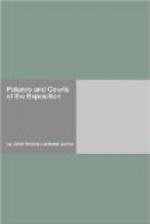“The whole scheme is to show the conception and birth of art, its translation to earth, its progress and acceptance by man.”
Below these murals, on the octagonal drum, is The Priestess of Culture, by Herbert Adams, eight times repeated.
This outline has been taken from the official report.
The dome of the Rotunda is burnt orange, with the guilloche below it worked out in turquoise green. Notice the great flower receptacles filled with the reddish cryptomeria of Japan.
In front of the Rotunda is Ralph Stackpole’s Kneeling Figure. She is a devotee to art, beauty, truth, and kneels at the altar.
Among the trees along the pergola are many statues in bronze and marble.
Don’t fail to see Janet Scudder’s bewitching fountain figures as you walk past the Pergola.
At the south, near the Pool, among the trees, sits St. Gauden’s fine “Lincoln.”
Opposite is J. Q. A. Ward’s statute of “Henry Ward Beecher.”
Around the corner, “The Bisons,” by Proctor.
Follow along by the Pool and you meet “The Scout,” by Cyrus Dallin.
No words can describe the great poetic beauty of this Fine Arts Palace. It seems to be the pivotal part of the Exposition, the goal of all pilgrimages, the altar on which you place your ideals. It has so many moods that one must see it in all seasons, during all times of the day, and especially under the illuminations.
The figure of “Aspiration,” by Leo Lentelli, is suspended — as is all aspiration — over the main entrance of the Fine Arts Palace.
Walk over to Administration Avenue so that you can look across the Pool at the panels.
They are by Bruno Zimm of New York.
They represent the Arts and a long procession of devotees.
In the center of one panel, called “The Unattainable in Art,” one sees Art represented. On either side is the battle between the idealists, the materialists and the artists.
Many idealists have fallen, but the centaurs, the materialists, seem to be held back by the artists who are striving to reach Art herself.
We are all striving to reach the so-called unattainable, but it means the battle with materialism before we can do it. Yonder stand beauty, health, truth — the flowers of the spirit — but we must pass the centaur to make that figure of Truth attainable.
Then comes the Apollo Panel, and Apollo, the leader of the arts, in his chariot, seems to be in a long procession preceded and followed by devotees of the fine arts.
Next comes the Pegasus Panel, indicating inspiration in the arts. Ahead, marches Music with his lyre, who, like a sort of Orpheus, is stilling even the beasts.
The figures between the panels represent those who stand ready to do battle for the arts.
Ulric H. Ellerhusen has done the flower boxes, with women at the corners. Vines were to have fallen over the figures from the boxes, allowing only a shoulder, a head, or a long line of the drapery to appear, but the plans had to be changed, hence the figure now in full evidence. The women are looking into the flower-laden boxes.




